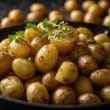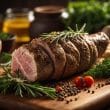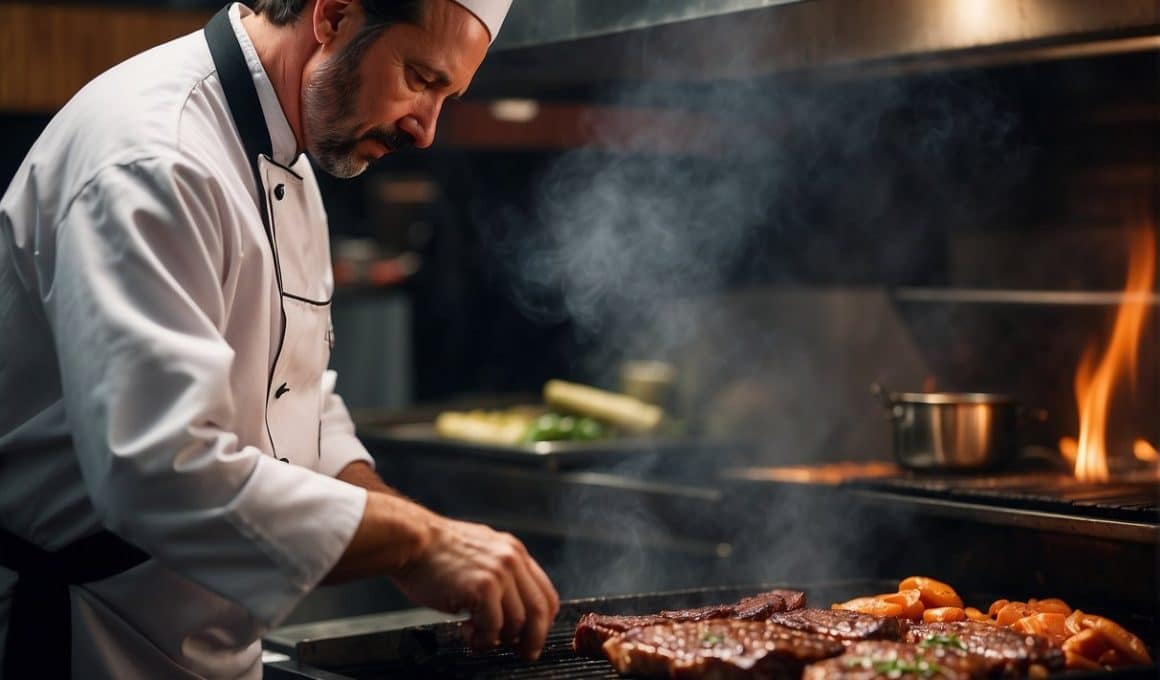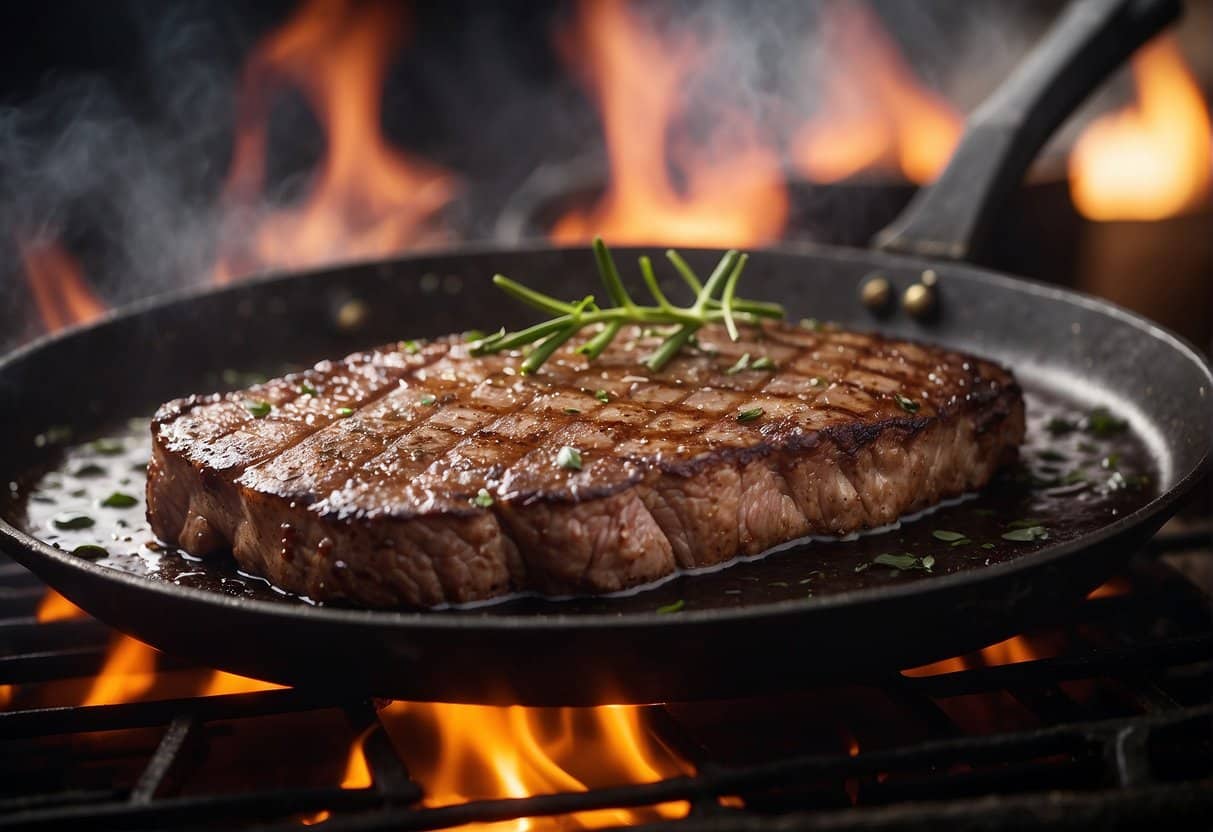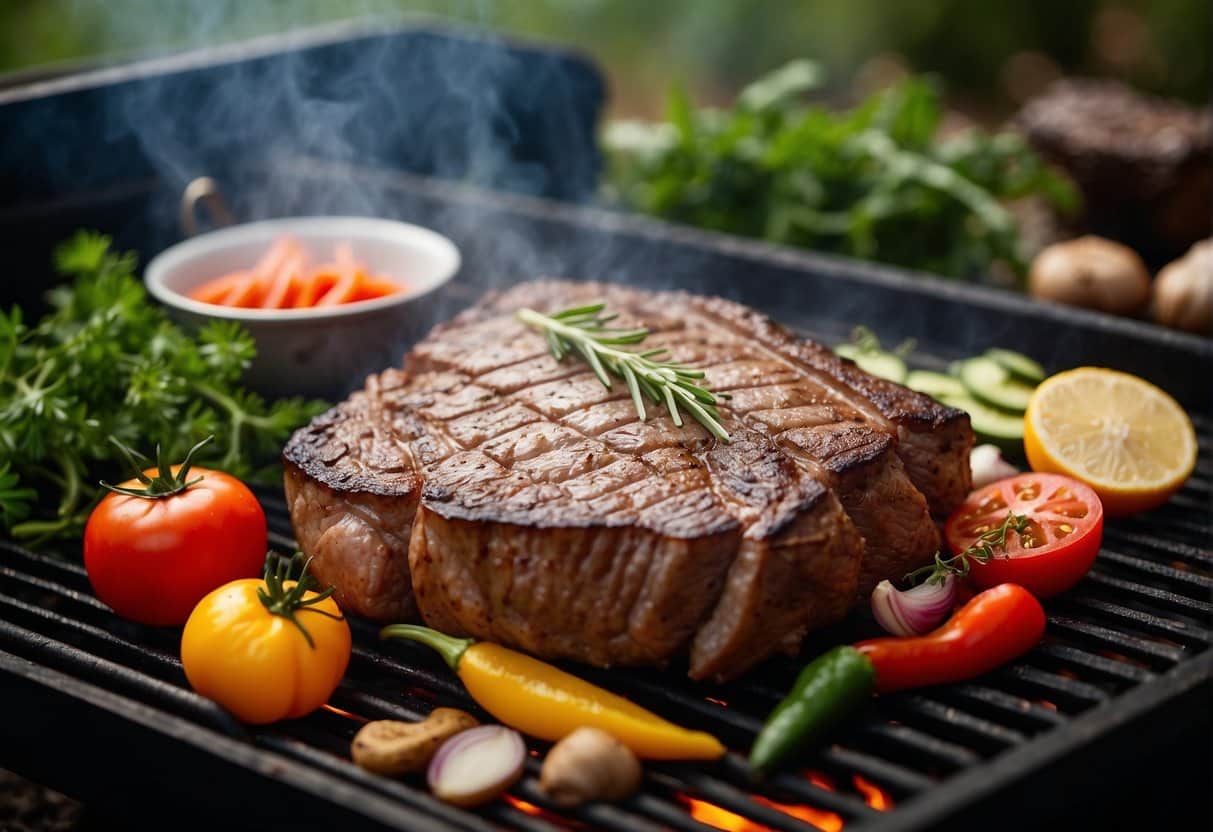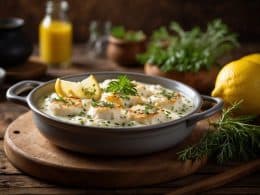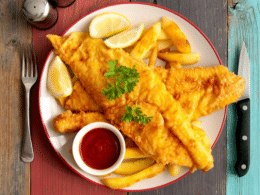Cote de boeuf, a culinary delight hailing from France, refers to a thick-cut rib steak still attached to the rib bone, famously known for its rich marbling and deep flavor. The cooking time of cote de boeuf is crucial, as it determines how well this sizable cut of beef will meld its array of textures and flavors. The ideal cooking technique varies by preference, often involving a combination of searing and oven roasting to reach the desired level of doneness.
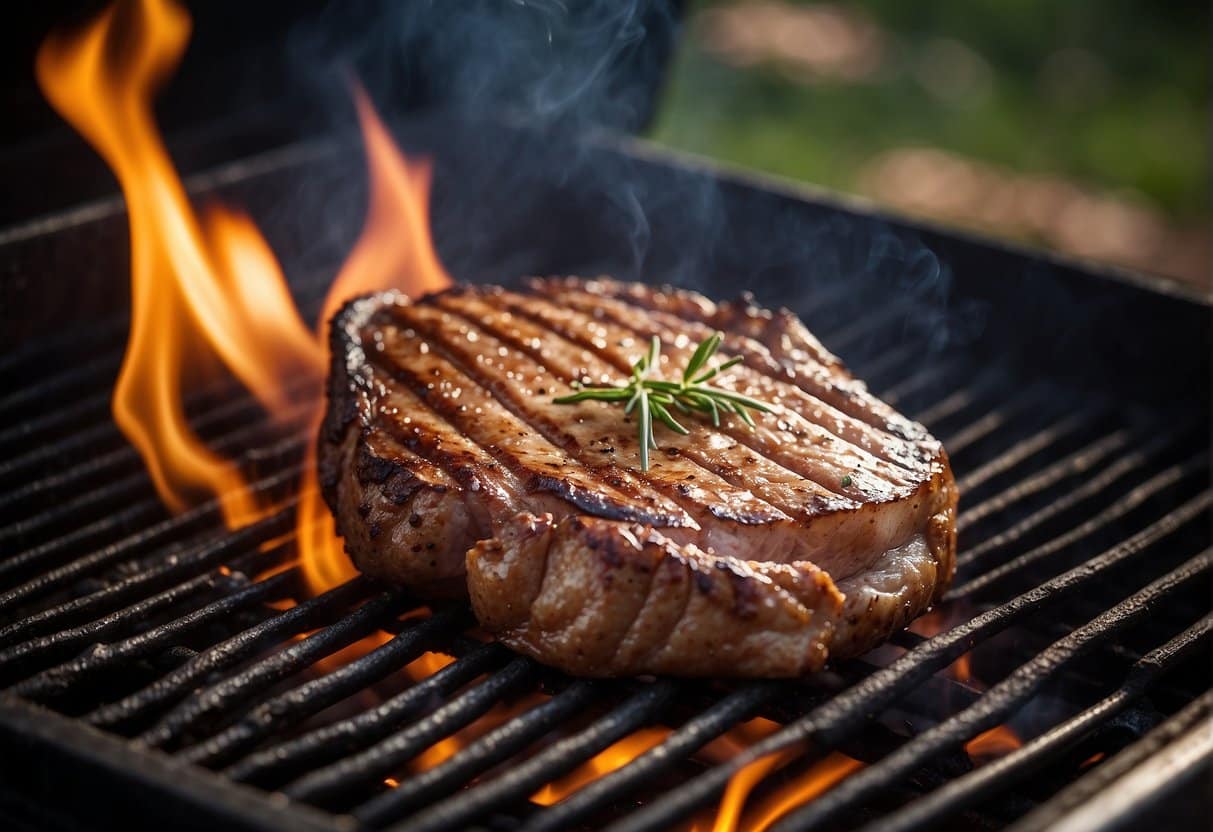
Given the thickness and weight of cote de boeuf, it generally requires a longer cooking period compared to thinner steaks, making the mastery of timing and temperature imperative. Cooking methods may include traditional oven roasting or the reverse sear method, where the steak is first cooked at a low temperature before being seared in a hot pan for a crispy exterior. Regardless of the method chosen, a reliable meat thermometer is my trusted companion to ensure the beef reaches the optimal internal temperature without guesswork.
Key Takeaways
- Properly timing cote de boeuf ensures a melding of flavors and textures.
- Mastery of cooking methods yields a desired degree of doneness.
- Always use a meat thermometer for accuracy when cooking cote de boeuf.
Selecting the Perfect Cut
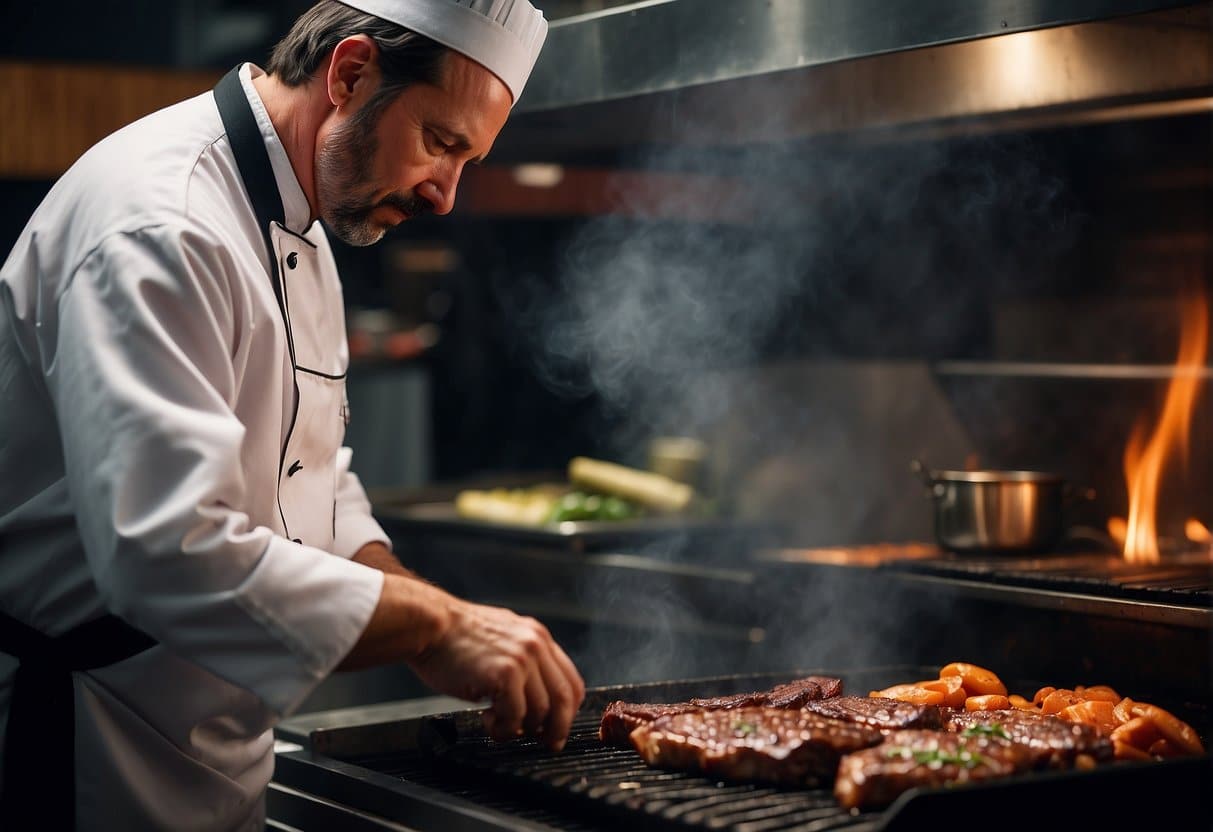
When I decide to prepare a cote de boeuf, my first priority is to choose the right cut of beef. This French term, cote de boeuf, refers to a bone-in ribeye steak and is renowned for its rich flavor and tender texture. To ensure the best results, I look for a cut with good marbling; the white specks of fat throughout the meat are key to a juicy and flavorful steak.
I prefer a well-marbled cote de boeuf, as it guarantees the meat will be succulent and rich. Marbling is not just about the fat, but about how it’s distributed throughout the beef. A well-marbled steak means that once cooked, the fat will render and baste the meat from the inside, creating a superior taste and texture.
When shopping, I usually choose to:
- Visit a trusted butcher or retailer.
- Look for beef with a bright red hue and creamy marbling.
- Ensure the meat has a good thickness, ideally about 2 inches, to allow for a proper sear on the outside without overcooking the interior.
If I opt to buy meat online, I make sure that:
- The retailer has a reputation for quality and freshness.
- The beef is well-packaged to maintain its condition during shipping.
- There are clear descriptions of the beef’s origin and marbling grade.
By taking these steps, I ensure that my cote de boeuf will not just be good, but exceptional. The perfect cut is out there; it only requires some attention to detail and a commitment to quality.
Preparation Techniques
Before diving into the preparation of a Cote de Boeuf, I ensure that my seasoning is spot on, the marination is tailored to the cut, and that the meat reaches the perfect room temperature for cooking.
Seasoning the Beef
I always start by seasoning my Cote de Boeuf liberally with salt and black pepper. Typically, I use a mixture of kosher salt or sea salt and freshly ground black pepper to cover the beef’s surface, which enhances its natural flavor. Sometimes, I’ll also include a touch of garlic powder or finely chopped fresh thyme for a more aromatic crust.
Marination Options
As for marination, I occasionally opt for a simple rub of olive oil paired with crushed garlic, mustard, tarragon, and thyme. This blend not only tenderizes the beef but also infuses it with complex flavors. I like to marinate for at least an hour or, if time allows, overnight in the fridge to allow these flavors to permeate deeper into the meat.
Bringing to Room Temperature
Prior to cooking, I make sure to take the meat out of the fridge and let it sit until it’s at room temperature. This crucial step ensures that the Cote de Boeuf cooks evenly and achieves a perfect sear. I find that 30 minutes to an hour is typically sufficient, depending on the cut’s thickness.
Cooking Methods
When I cook côte de boeuf, selecting the right cooking method is crucial to achieve the desired texture and flavor. Whether I’m using my oven for roasting, pan searing on the stovetop, or grilling over BBQ, understanding the nuances of each method helps me to produce the perfect steak.
Oven Roasting
I begin by preheating my oven to the appropriate temperature before placing the côte de boeuf. For oven roasting, I warm up the oven to around 180°C (160°C if using a fan oven) or Gas Mark 4. This method is great for an even cook throughout the steak. I place the beef on a baking tray and roast it until it reaches the desired internal temperature.
Pan Searing
When I’m looking to create a beautifully caramelized crust on my côte de boeuf, I opt for pan searing. I start by heating a frying pan or griddle pan on high heat until just smoking. Then, I sear each side of the steak to lock in the flavors before I sometimes finish it off in the oven, especially for thicker cuts.
Grilling on BBQ
For that irresistible smoky flavor, I turn to my BBQ grill. First, I preheat the grill to a high temperature to achieve a good sear. I then set the côte de boeuf on the grill using indirect heat to allow a slower cooking process, which helps in keeping the steak juicy and tender.
Determining Doneness
When I cook cote de boeuf, achieving the perfect doneness is crucial to the dish’s success. I rely on precise methods to ensure it’s cooked to my guest’s liking, be it rare, medium-rare, or medium.
Using a Meat Thermometer
To assure accuracy, I use an instant-read meat thermometer to check the internal temperature. For rare, I look for an internal temperature of around 49-51°C (120-125°F). A medium-rare steak should read 52-54°C (125-130°F), while medium doneness reaches 55-57°C (130-135°F). It’s important to insert the thermometer into the thickest part of the meat without touching bone or fat for a correct reading.
Visual and Tactile Cues
In addition to a thermometer, I observe visual and tactile cues. Rare cote de boeuf will have a warm, red center, medium-rare will be mostly pink with a hint of red, and medium steaks will feature a warm, pink center. I press the meat lightly; it should feel soft for rare, have a slight spring for medium-rare, and be firmer to the touch for medium. Using these indicators together with a thermometer ensures perfect doneness every time.
Resting and Carving
Once I remove my Cote de Boeuf from the heat, I ensure it rests properly before carving. This process is crucial for serving the best possible steak.
Why Resting is Essential
Resting allows the juices in my Cote de Boeuf to redistribute, resulting in a moist and tender steak. I typically rest the meat on a wire rack to avoid sogginess at the bottom. The recommended resting time is generally about half the time it was cooked. For a medium-rare steak, a 10-minute rest is sufficient.
Best Practices for Carving
Carving is an art that begins with the right tools – a sharp knife and a sturdy cutting board. I always slice against the grain for maximum tenderness. Holding the knife at a slight angle, I make decisive cuts to turn my Cote de Boeuf into even slices. Serving on a warm platter enhances the experience.
Sides and Accompaniments
Choosing the right sides and accompaniments can elevate the experience of enjoying a cote de boeuf. I’ll lay out some refined options that pair beautifully with this rich cut of beef, considering the balance of textures and flavors.
Vegetable Pairings
In my experience, roasted vegetables are a splendid choice. They add a depth of flavor that complements the beef superbly. I particularly enjoy a mix of roasted carrots, Brussels sprouts, and asparagus. The slight char brings a delightful contrast, and when seasoned well, they enhance the overall dish immensely. A rocket salad, with its peppery notes, provides a fresh and crisp counterpoint to the meat’s richness.
Starchy Sides
Starchy sides are essential for a well-rounded meal, and potatoes come in many forms to suit this role. Fries are a classic, giving a pleasing crunch to the meal. For something more indulgent, mashed potato with a touch of cream and butter offers a smooth and comforting texture. I find that these starchy sides not only complement the main in terms of taste but also provide a pleasant variety in texture.
Sauces and Condiments
Sauces and condiments add that final touch that ties the meal together. A simple sauce, perhaps a red wine reduction or a peppercorn sauce, can be particularly tempting with cote de boeuf. The key is to ensure that the sauce is rich but not overpowering, enhancing the meat’s natural flavors rather than masking them.
Finishing Touches and Presentation
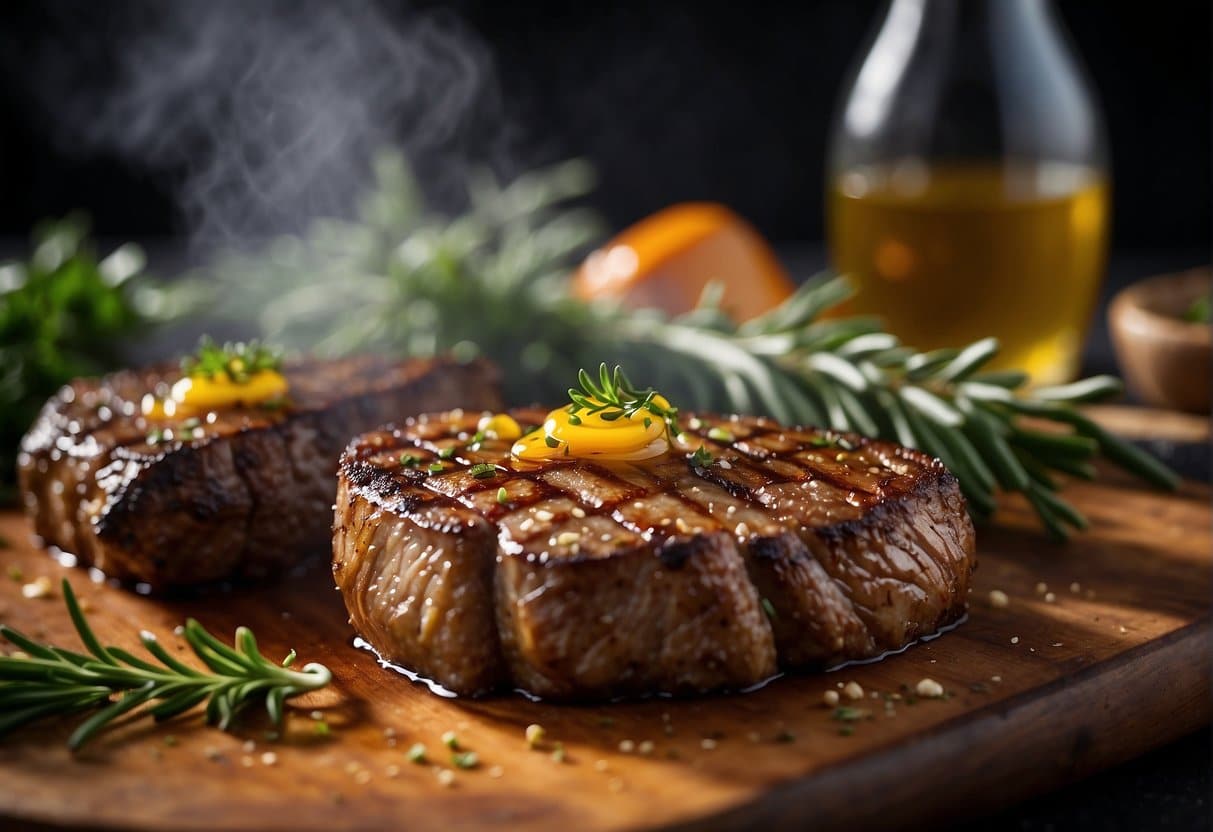
After carefully tending to the cote de boeuf, I know that the final steps are crucial for a memorable dish. The right garnishes and thoughtful plating turn this robust steak into the star of any celebration.
Garnishes and Herbs
In my experience, a dollop of compound butter flavored with tarragon leaves and a hint of lemon juice promises to complement the cote de boeuf’s caramelised exterior beautifully. I sometimes like to add a fine chop of shallot to the butter for an extra burst of flavor. Butter helps to add a glossy, luxurious finish to the meat and the herbs bring freshness that cuts through the richness.
Plating Recommendations
For plating, I ensure the foundation is just right. I start with a warm, large plate to maintain the temperature of the meat. Then, I’ll carefully place the cote de boeuf in the center, allowing the caramelised crust to be fully visible. A drizzle of sauce, perhaps a reduction made with a touch of vinegar and brandy, adds depth and acidity. Next to the steak, a simple garnish such as a lemon wedge or a sprig of tarragon can add a spot of color and indicate the flavors within the butter. With each cut into the cote de boeuf, my guests can expect a fork-tender, flavor-packed experience.
By focusing on these finishing touches and presentation strategies, I ensure the meal is not just about satisfying hunger—it’s about creating an experience.
Nutritional Information
When I cook a Côte de Boeuf, also known as a bone-in ribeye steak, I’m not just preparing a delicious meal, I’m also mindful of its nutritional content. Here’s a concise breakdown of what you can expect from a typical serving size, which is approximately 3 ounces (85 grams) of cooked beef:
Calories: Depending on how it’s prepared, a serving provides about 210 calories. The number can vary based on additional ingredients used in cooking, such as oils or butter.
Protein: Beef is renowned for its high protein content, and a serving of Côte de Boeuf offers a substantial 20 grams, contributing to muscle growth and repair.
Fat: There’s around 14 grams of fat in a serving, with 6 grams being saturated fat. My aim is to balance my diet with leaner cuts and various cooking methods to control fat intake.
Vitamins and Minerals: While Côte de Boeuf isn’t rich in Vitamin A or Vitamin C, it does provide other nutrients. Iron, which is vital for blood health, and zinc, which supports the immune system, are found in notable amounts.
Italicized below is the usual vitamin content:
- Vitamin A: Negligible
- Vitamin C: Negligible
But it’s worth mentioning that incorporating a side of vegetables can not only enhance the flavor of your dish but also boost the intake of these vitamins.
In terms of recommended daily intake, it’s essential to consider that beef should be a component of a diverse diet, including a variety of protein sources, vegetables, fruits, grains, and healthy fats, to ensure a well-rounded nutritional profile.
Frequently Asked Questions
When preparing a Cote de Boeuf, the key to perfect doneness lies in understanding the cooking time, achieving the right internal temperature, distinguishing it from similar cuts, and mastering a basic recipe. Here’s what you need to know.
How long should you cook a Cote de Boeuf in the oven?
Typically, for a Cote de Boeuf that weighs around 2-2.5 pounds, you’ll want to oven-roast it at a low temperature, such as 275°F (135°C), for about 1.5 to 2 hours. However, the exact time can vary based on the oven and the steak’s size and thickness.
What internal temperature should you aim for a medium-rare Cote de Boeuf?
For a medium-rare finish, aim for an internal temperature of 130°F to 135°F (54°C to 57°C) before resting. Testing with a meat thermometer ensures accuracy.
What is the difference between a Côte de boeuf and a tomahawk steak?
The primary difference is in the bone; a Côte de boeuf has a shorter bone, while a tomahawk steak features a long, frenched bone that resembles an axe handle. Both are rib steaks and taste similar.
Can you provide a basic recipe for preparing Côte de Boeuf?
Certainly, for a basic Côte de Boeuf, season the steak with salt and pepper, sear it in a hot skillet for a rich crust, then transfer to the oven for slow cooking until it reaches the desired doneness.
What is a well-done internal temperature for Cote de Boeuf?
For a well-done Cote de Boeuf, aim for an internal temperature of 160°F (71°C) or above. Keep in mind that higher temperatures may result in a less juicy steak.
How long does it take to grill a Cote de Boeuf to perfection?
Grilling a Cote de Boeuf to medium-rare perfection typically takes about 12-14 minutes, flipping every 30-40 seconds after a initial sear over high heat. Again, this can vary with thickness and grill temperature.


